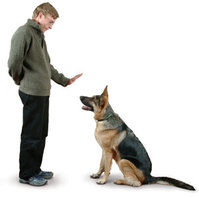Can Dogs Learn Sign Language?
The simple answer to this Holidays4Dogs question is – yes, dogs can learn sign language! Dogs are especially astute when it comes to visual signals and can understand gestured commands just as easily as verbal ones. In fact, in most cases, dogs respond better to visual, rather than verbal cues. The speed of their response is quicker if the two are used both together – all you need to do is teach them what the various signals mean.
Studies have shown that all dogs are capable of following the direction of a pointed finger; something that even chimpanzees, or apes, are unable to do. Many deaf dogs can benefit from learning visual signs, but any dog can learn visual signals that can be useful in all sorts of situations.
Dogs are also capable of learning by observation from other other dogs and this involves an element of learning behavioural cues and signals.
My Chihuahua knows that a – ‘thumbs up’ – means ‘good’ and a treat is coming. My elderly collie, whose hearing has grown weak, understands that two arms spread out wide means, ‘come back’.
A classic example of a dog learning sign language is in gundog training. In this discipline, dogs learn to understand hand signals indicating them to go left, right, or back.
Many competitive obedience dogs learn hand signals too. Teaching your dog sign language is a great way to enhance the bonding process with any pet dog. This doesn’t mean you have to stop talking to your dog – even if they’re deaf.
What hand signals should I use?
It’s really up to you what signs you want to teach your dog, but all can be invaluable throughout your dog’s life – especially as they age and becomes less able to hear audible cues.
Perhaps the most important sign to teach first is ‘watch me’. This can be used to get your dog’s attention before teaching other signals. Hold a treat up to your nose. As soon as your dog is settled, and looking directly at your face, reward your dog straight away with the treat.
‘Thumbs up’ is a handy signal to show your dog you are pleased with his behaviour. A hand signal, such as a palm facing up is good for teaching your dog sit. A palm facing down, or a downward arm movement, can signal to your dog you want them to lie down. A palm facing forward might indicate you want your dog to stay.
How can I teach hand signals?
For a hearing dog, you can pair the visual cue with a verbal one to begin with. If they already know a verbal cue such as sit, this will help them to learn the visual sign.
For hearing impaired dogs the timing of rewards is important. It is also helpful to begin training the deaf dog somewhere where there are no distractions. This will help with your dog’s initial concentration levels.
Also, you may need to over-exaggerate your visual signals to start with. To find out more about living with a deaf dog follow this link.
Conclusion.
Always remember to be consistent and patient and your dog will soon learn how to read visual signals from you, something which will be not only fun for you both, but will also deepen the bond between you.



